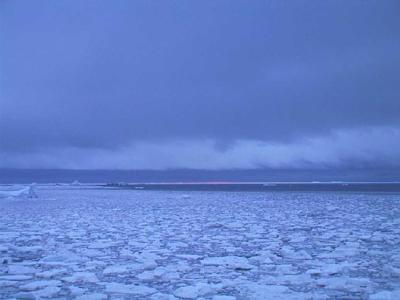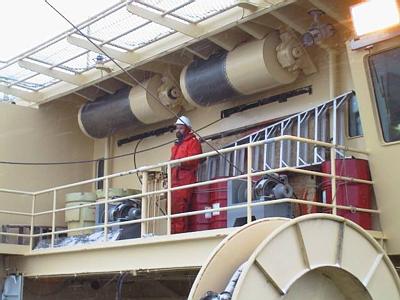
|
|
8 March, 2000
Frequent Flying Picture
72 08 s, 118 55 w
-5 C (23 F)
Wind 24 knots (28 mph) from southeast.
Barometer 981 mb, steady
Depth 739 meters (2425 ft)
Ship headed generally northeast, following and mapping continental shelf edge
Stopping periodically for CTDs and cores
I woke up this evening and outside the porthole of my cabin it was
snowing heavily, big flakes of it passing by sideways in the deck lights.
Outside I could barely see beyond the rail of the ship, but I could tell by
the sounds of the SeaBeam pings that we were in about 600 meters of water.
From the clang of ice on the sides of the ship I could tell we were in
ack ice, medium sized floes of old, rotten multi year ice. Occasionally the
ship would lurch to one side or another, which told me there were some
bigger, more solid pieces. These push the ship around as much as the ship
pushes them.
I went down to the galley to midrats, to put something in my
stomach, and some coffee in my head. Being a cook on a ship must be
difficult. You have little space to work in, and that space is often
rocking back and forth. But I'm amazed at what the Nathaniel B. Palmer's
galley crew comes up with. Tonight it was Pizza, soup, pancakes, scrambled
eggs, grits, or oatmeal. Not to mention fresh baked bread, cookies and
doughnuts. The pizza was for people going off watch, not those just waking
up. I'm a big oatmeal fan. I realize that a lot of you are not, but I'm
sure you would find something here to look forward to. Feeding cold tired
people in Antarctica takes lots of planning and hard work.
After another cup of coffee I went up to the bridge to look around
and find out what was happening. The view from the bridge was like the view
from a car travelling in a snowstorm at night. The bright spotlights lit up
snow, and the visibility was only a hundred meters. The radar and the
SeaBeam could see much further though. The first looked miles ahead through
the snow, and the second looked a half mile below at the bottom.
Tom Kellogg was on the bridge, watching the SeaBeam output paint a
picture of the shelf break as we went along. We talked for while about what
he was learning on the cruise, and the questions he was trying to answer.
Scientists on board seem always willing to discuss science, which I don't
mind doing at all.
Speaking of seeing, let me show you a picture of a part of Antarctica
taken from space.
One picture with this journal looks like a black and white photo,
but it is really a radar image of the Thwaites Glacial Tongue and the
eastern part of the Bear Peninsula, taken by a Canadian Space Agency
satellite called Radarsat, an active microwave satellite. The picture you
are getting on your computer screen is just a degraded shadow of the
original. If you've ever photocopied a picture, then photocopied the copy,
and copied that copy, then you know what I mean. If you enlarge this image
on your screen, you will quickly see individual pixels, or squares. The
original image had very high resolution, and had the 94 meter (308 foot)
Nathaniel B. Palmer been in the area, it would have been detectable, and
you might have been able to pick out the lifeboats.
This image has been a long way in getting to your screen. The
satellite scanned the area, stored up the information, and perhaps sent it
to earth as it passed over Canada. The Canadians then sent a copy to Dr.
Shusun Li aboard the ship, via another satellite. They sent a slightly
lower resolution copy, because the original would have taken a long,
expensive time to send. I copied the image, and degraded it further, so I
could send it back over a third satellite, to Denver. From Denver it goes
out on the Internet to you. If pictures could get frequent flyer miles,
this one could fly for free.
Take a look at the image. It may help you to print this description and
have the image in front of you. The center of the picture is at about 74
degrees, 15 minutes south, 107 degrees, 0 minutes west. North is in the
upper right corner and south in the lower left. The biggest thing in the
picture is the Thwaites Glacier tongue (not the same as the now gone
Thwaites Iceberg Tongue) in the lower left. It is about 56 km (34.5 miles)
across. Halfway up the left hand edge of the picture you can see the
eastern part of the Bear Peninsula. The glacier tongue is floating, and is
some hundred or more meters thick. Notice the bay between the glacial
tongue and Bear Peninsula. From that bay extending almost to the upper
right corner of the picture you will see an area slightly lighter in shade
than its surroundings. This is the "fast ice" area I was talking about in a
recent journal entry. It is located where the Thwaites Iceberg Tongue used
to be. There is also an area of fast ice along the right hand portion of
the bottom of the image.
Notice that embedded in that fast ice area are a number of icebergs, large
and small. They look like little white chips. There are more icebergs here
than anywhere else in the picture. The largest one, in the upper central
portion of the image, reminds me of Indiana. I confess I don't remember the
exact shape of Indiana, but I think it looks like that iceberg. This berg
is about fifteen kilometers (9.3 miles) square, and is just to the left or
west of the fast ice area. Two other long thin bergs, maybe fifteen
kilometers long, are embedded in the fast ice between Indiana and the bay.
Many of these icebergs are probably grounded, although we cannot be sure.
In the area where the fast ice is we don't know the depth. Even a stronger
ice breaker than the NBP would have difficulty getting through the fast
ice. I know some icebergs touch bottom, because when ping editing I can
see the places on the bottom where current or wind driven bergs have plowed
the bottom sediment in long grooves.
The rest of the ocean shown in the images is relatively dark. Some
of this may be open water, some new ice, some pancake ice, and some floes.
You can see pack ice along the upper right edge of the picture, to the
right of Indiana. Sometimes it's hard to tell open water from new ice, and
rough water from pack ice. Looking at visual images helps interpret radar
images, if there are no clouds to block the scenery. Remember that
microwave satellites can see through clouds and at night. The work being
done aboard the Nathaniel B. Palmer by the "ice people" will help make
interpreting these microwave pictures easier and more accurate.
Just to the right (east) of Bear peninsula, in the left central
portion of the picture, there is a large, slightly darker berg the shape of
a stubbed out cigarette. North of it is a darker area, which could be new
ice or maybe open water. It looks like the berg has moved south through the
ice or the ice moved north past the berg. The second choice is correct. The
eastern (left) half of the bay isn't really fast ice, it is heavy pack. You
can see a faint dividing line between fast and pack. The pack ice has blown
northward past the grounded cigarette butt, leaving a "shadow" behind it.
A picture is worth a thousand words. You've gotten the thousand
words and the picture!
An update: I still haven't gotten the word on penguin's knees, but
I did find the missing sock.

Part of the Thwaites Glacier Tongue, as seen from a passing microwave satellite. The upper right part of the picture is where the cold tongue isn't.

A cold morning in the pack ice.

Jay Ardai operates a winch. Like many of the ship's support staff, Jay can do many different jobs. He can solve computer problems as well as get a stuck piston core apart, all in a day's work. The deck above his head is the ship's helicopter pad. The netting around the edge is there instead of a railing, which would interfere with the helicopter's landing approach.
Contact the TEA in the field at
.
If you cannot connect through your browser, copy the
TEA's e-mail address in the "To:" line of
your favorite e-mail package.
|
